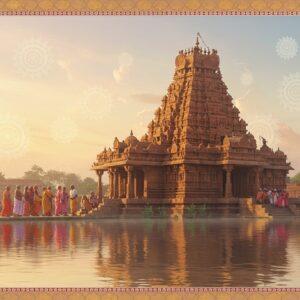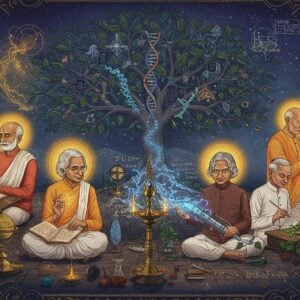
Nestled on the breathtaking Swami Rock in Trincomalee, Sri Lanka, the Koneswaram Temple stands as a beacon of Hindu devotion and Tamil heritage. This sacred site, steeped in centuries of history, whispers tales of ancient legends, royal patronage, colonial struggles, and unwavering faith. Join us as we unravel the captivating story of Koneswaram, a testament to the enduring spirit of a community that cherishes its traditions.
Whispers from the Past: Ancient Origins and Legendary Beginnings
The origins of Koneswaram Temple are shrouded in mystique, its roots stretching back to Naga Nadu, a time before 377 BCE. Some records even hint at roots as far back as 1580 BC. This sacred ground finds mention in ancient epics like the Mahabharata and Ramayana (400-100 BCE). Legend has it that the mythical king Ravana himself worshipped at this very spot, further adding to the temple’s aura. The temple’s location on Swami Rock itself holds deep spiritual significance, intertwining with the epic tale of Ramayana.
Over the centuries, the temple complex evolved. Around 235 BCE, Elara Manu Needhi Chola further developed the site. Later, between 103-88 BCE, Chola king Kankan (“Kullakottan”) restored the temple, ensuring its continued sanctity. The temple’s early history reveals its profound influence on the spiritual and cultural life of early South Indian and Sri Lankan societies.
Royal Patronage and Flourishing Devotion
During the medieval period, Koneswaram Temple blossomed under the generous patronage of both the Chola and Pandyan dynasties. From the 4th to 7th centuries AD, kings generously donated, contributed, and renovated Koneswaram. The sixth and seventh centuries CE saw the composition of beautiful hymns dedicated to the temple deities during the reign of the Pallava kingdom. The Chola empire, too, lent its support between the 10th and 12th centuries CE. Sinhalese King Gajabahu II (1131-1153 CE), although ruling from Polonnaruwa, deeply revered Shiva and generously supported Koneswaram. Later, in the 13th century, the Pandyan kingdom further contributed to the temple’s magnificence.
These royal contributions transformed Koneswaram into a vibrant hub of religious pilgrimage and cultural exchange. Inscriptions and historical records bear witness to the dedication of various rulers in maintaining and enriching this sacred space. The Jaffna kingdom (1215–1620 CE) oversaw a period of continued prosperity for the temple.
A Time of Trial: Colonial Impact and the Path to Restoration
The 17th century brought a period of hardship for Koneswaram. Between 1622 and 1624, Portuguese colonizers, driven by socio-political motives, tragically demolished the temple complex. A fort was even built at the site using the temple’s debris. This act of destruction resulted in an immeasurable loss of cultural heritage. Despite the immense loss, the local community displayed incredible resilience, bravely preserving their religious practices despite the oppression.
The spirit of Koneswaram could not be extinguished. The 17th century also witnessed the restoration of the temple, a testament to the unwavering devotion of the people. The 18th to 20th centuries, known as the Swami Rock period, marked a time of rediscovery. Archaeological excavations unearthed precious artifacts, providing invaluable insights into the temple’s rich past. Finally, in the 20th century, through the dedicated efforts of philanthropists and spiritual leaders, Koneswaram Temple was lovingly reconstructed, reclaiming its position as a cherished spiritual haven.
Koneswaram Today: A Symbol of Enduring Faith
Today, Koneswaram Temple stands as a vibrant testament to the enduring power of faith. It serves as a major pilgrimage site for Hindus worldwide, attracting devotees with its rich history, stunning architecture, and sacred atmosphere. The temple’s influence extends beyond religious practices, impacting the local economy and shaping the cultural identity of the region. Festivals, rituals, and traditions observed at Koneswaram draw devotees and visitors from across the globe, creating a tapestry of shared devotion.
Architectural Marvels and Artistic Expressions
The temple’s Dravidian architectural style is a feast for the eyes. Intricate carvings, expressive sculptures, and vibrant murals adorn its walls, depicting deities, mythological scenes, and stories from ancient texts. Each element carries deep symbolism and religious significance, inviting contemplation and reverence. The temple’s location atop Swami Rock adds to its allure, offering breathtaking panoramic views of the vast Indian Ocean.
Explore the Pallikondeswara Temple
Discover the Bhoganandishwara Temple
Connect with the Sacred: Poojn.in Brings Temple Traditions Home
At Poojn.in, we understand the deep connection devotees feel towards sacred spaces like Koneswaram Temple. That’s why we offer a curated collection of authentic puja items, allowing you to bring the sanctity of temple rituals into your home.
- Pure Copper Kalash Sets: Essential for traditional water rituals and abhishekam, just like those performed in temples. Our Kalash sets are crafted with utmost care to ensure purity and authenticity.
- Traditional Oil Lamps: Illuminate your home with the warm glow of brass and copper lamps, reminiscent of those used in temple ceremonies. Choose from a variety of designs and sizes to suit your prayer space.
- Authentic Vibhuti: Sacred ash for applying tilak, a revered practice in Shiva temples. Our vibhuti is sourced from trusted sources and packaged with care to maintain its sanctity.
- Pure Cotton Wicks: Light your traditional lamps with pure cotton wicks, ensuring a clean and steady flame during your prayers. Available in convenient packs for regular use.
- Genuine Camphor: Enhance your aarti ceremonies with the purifying aroma of genuine camphor. We offer high-quality camphor to elevate your spiritual practices.
We meticulously source and quality-check each item to meet the high standards expected in sacred rituals and ceremonies. With convenient delivery across India, you can access traditional puja items without compromising on authenticity.
Need personalized guidance? Our team is here to assist you. Call us at 03369029784 or WhatsApp us at 9476142738. We’ll help you select the perfect items that align with temple traditions while meeting your specific needs.
Find Exquisite Copper Items
Explore our Murti Collection
Visit Poojn.in today to explore our complete range of temple-grade puja items.
Common Questions About Koneswaram Temple
Who originally built Koneswaram Temple? While King Kulakkottan is credited with constructing the temple during the Chola dynasty, its origins are shrouded in antiquity, with some believing the temple existed centuries before his reign.
Can you share the history of Koneswaram Temple? The over 2,000-year history of Koneswaram Temple is a tapestry woven with threads of ancient legends, royal patronage, colonial destruction, and eventual restoration. It stands as a symbol of resilience and unwavering faith.
Was Koneswaram Temple built by Ravana? Legend associates King Ravana with worshipping at the temple, but historical evidence points to its construction during the Chola dynasty. This doesn’t diminish the mystical aura surrounding the temple, as it is revered as a sacred place in the Ramayana epic.
What are the notable features of Koneswaram Temple? The temple’s Dravidian architecture, intricate carvings, and stunning sculptures are complemented by its breathtaking location atop Swami Rock, offering panoramic views of the Indian Ocean.
What makes Koneswaram Temple so significant? Koneswaram holds immense historical, cultural, and religious significance, especially for the Tamil community. It’s considered one of the Pancha Ishwarams, five ancient Shiva temples in Sri Lanka.
How can I visit Koneswaram Temple? The temple is located in Trincomalee, Sri Lanka, easily accessible by road. You can journey to this sacred site and experience its spiritual atmosphere firsthand.
What kind of rituals take place at Koneswaram Temple? Various pujas, offerings, and traditional prayers are performed at the temple. Devotees seek blessings, participate in ceremonies, and celebrate religious festivals within its sacred walls.
Are there any legends connected with Koneswaram Temple? Numerous legends surround the temple, including tales of King Ravana and other miraculous events. These stories enrich the temple’s history and add to its allure for spiritual seekers.


